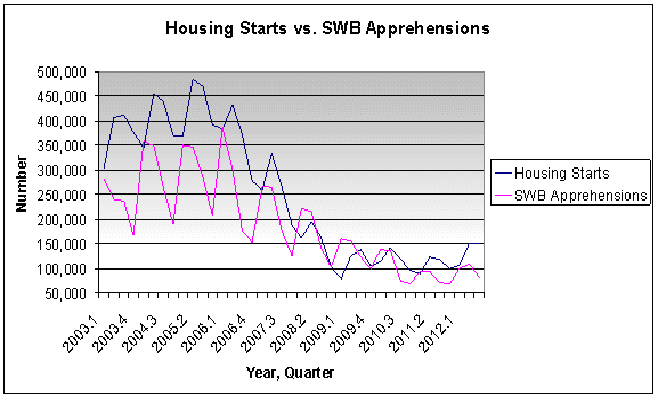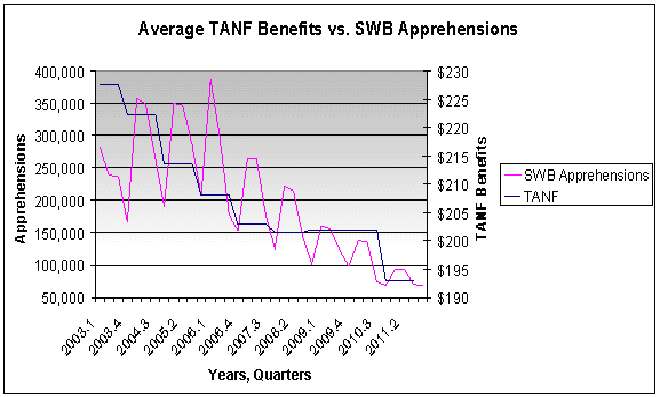This post was originally published on the Cato-at-Liberty blog here and is republished with the permission of the author.
There are indications that The Heritage Foundation may soon release an updated version of its 2007 report, “The Fiscal Cost of Low-Skill Immigrants to the U.S. Taxpayer,” by Robert Rector. That 2007 report’s flawed methodology produced a grossly exaggerated cost to federal taxpayers of legalizing unauthorized immigrants while undercounting or discounting their positive tax and economic contributions – greatly affecting the 2007 immigration reform debate.
Before releasing its updated report, I urge the Heritage Foundation to avoid the same serious errors that so undermined Mr. Rector’s 2007 study. Here is a list of some of its major errors:
- Count individuals, not households.[1] Heritage counts household use of government benefits, not individual immigrant use. Many unauthorized immigrants are married to U.S. citizens and have U.S. citizen children who live in the same households. Counting the fiscal costs of those native-born U.S. citizens massively overstates the fiscal costs of immigration.
- Employ dynamic scoring rather than static scoring. [2] Heritage’s report relies on static scoring rather than dynamic scoring, making the same mistake in evaluating the impact of increased immigration on welfare costs that the Joint Committee on Taxation makes when scoring the impact of tax cuts. Instead, Heritage should use dynamic scoring techniques to evaluate the fiscal effects of immigration reform. For example, Heritage should assume that wages and gross domestic product are altered considerably because of immigration policy reforms. In contrast to that economic reality, immigrant wages, gross domestic product, and government welfare programs are unrealistically static in Mr. Rector’s study. His study largely ignores the wage increases experienced by immigrants and their descendants over the course of their working lives, how those wages would alter after legalization, and the huge gains in education amongst the second and third generation of Hispanics.[3] Heritage is devoted to dynamic scoring in other policy areas – it should be so devoted to it here too.[4]
- Factor in known indirect fiscal effects.[5] The consensus among economists is that the economic gains from immigration vastly outweigh the costs.[6] In 2007, Mr. Rector incorrectly noted that, “there is little evidence to suggest that low-skill immigrants increase the incomes of non-immigrants.” Immigrants boost the supply and demand sides of the American economy, increasing productivity through labor and capital market complementarities with a net positive impact on American wages.[7] Heritage should adjust its estimates to take account of the positive spill-overs of low-skilled immigration.
- Assume that wages for legalized immigrants would increase – dramatically.[8] Heritage did not assume large wage gains for unauthorized immigrants after legalization. In the wake of the 1986 Reagan amnesty, wages for legalized immigrants increased – sometimes by as much as 15 percent – because legal workers are more productive and can command higher wages than illegal workers. Heritage should adopt similar wage increases to estimate the economic effects of immigration reform if it were to happen today.[9]
- Assume realistic levels of welfare use.[10] Vast numbers of immigrants will return to their home countries before collecting entitlements,[11] the “chilling effect” whereby immigrants are afraid of using welfare reduces their usage of it, and immigrants use less welfare across the board.[12] 100 native-born adults eligible for Medicaid will cost the taxpayers about $98,000 a year. A comparable number of poor non-citizen immigrants cost approximately $57,000 a year – a 42 percent lower bill than for natives. For children, citizens cost $67,000 and non-citizens cost $22,700 a year – a whopping 66 percent lower cost. Heritage should adjust its estimates of future immigrant welfare use downward. [13]
- Use latest legislation as benchmark.[14] The current immigration plan, if rumors are to be believed, would stretch a path to citizenship out for 13 years.[15] Most welfare benefits will be inaccessible until then, so Heritage’s report must take that timeline into account.
- Remittances do not decrease long term consumption.[16] Remittances sent home by immigrants will eventually return to the U.S. economy in the form of increased exports or capital account surpluses. Heritage should recognize this aspect of economic reality rather than assuming remittances are merely a short-term economic cost.
- Factor in immigration enforcement costs.[17] Heritage did not compare costs of legalization and guest workers to the costs of the policy status quo or increases in enforcement. The government spends nearly $18,000 per illegal immigrant apprehension while the economic distortions caused by forcing millions of consumers, renters, and workers out of the U.S. would adversely affect income and profitability.[18]
- Use transparent methodology.[19] Heritage’s methodology should replicate that of the National Research Council’s authoritative and highly praised – even by immigration restrictionists – study entitled The New Americans.[20] That study is the benchmark against which all efforts at generational fiscal accounting – including Heritage’s 2007 report – are measured. If Heritage deviates from their methods, it should explain its methodology in a clear and accessible way that states why they altered practice.[21]
- Don’t count citizen spouses.[22] Heritage counted U.S.-born spouses of unauthorized immigrants as fiscal costs. Counting the net immigrant fiscal impact means counting immigrants and perhaps their children at most,[23] not native-born spouses who would be on the entitlement roles regardless of whether they married an immigrant or a native-born American.
- Suggest changes to the welfare state. Heritage has elsewhere called low-skill migrant workers “a net positive and a leading cause of economic growth”[24] and accurately reported that “[t]he consensus of the vast majority of economists is that the broad economic gains from openness to trade and immigration far outweigh the isolated cases of economic loss.”[25] Instead of arguing against low-skill immigration, Mr. Rector should instead suggest reforms that would, in the words of Cato’s late Chairman Bill Niskanen, “build a wall around the welfare state, not around the country.”[26]
It is imperative that the economic costs and benefits of increased immigration be studied using proper methods and the most recent data. A previous report by the Heritage Foundation in 2006 entitled, “The Real Problem with Immigration … and the Real Solution,” by Tim Kane and Kirk Johnson roundly rejected the negative economic assessments of Mr. Rector’s 2007 study.[27] Not only does Mr. Rector not speak for the broad conservative movement; it appears that economists who have worked for the Heritage Foundation also disagree with Mr. Rector’s conclusions.
For decades, the Heritage Foundation has been an influential intellectual force in conservative circles. Its economic analyses have been predicated on consideration of the dynamic effects of policy changes as opposed to static effects. Unfortunately, Mr. Rector’s past work has not been consistent in this regard, employing the same static scoring conservatives have traditionally distrusted in other policy areas.
Many conservatives rely on the Heritage Foundation for accurate research about immigration’s impact on the economy. Before releasing another study assessing the net fiscal impacts of immigration reform, Heritage should correct the errors outlined above to guarantee the most accurate information on this important topic is available.
[1] Rector and Kim, “The Fiscal Cost of Low-Skill Immigrants to the U.S. Taxpayer,” Heritage Special Report, SR-14, May 21, 2007, p. 1.
[2] Rector and Kim, “The Fiscal Cost of Low-Skill Immigrants to the U.S. Taxpayer,” Heritage Special Report, SR-14, May 21, 2007, p. 14.
[3] Fry and Lopez, “Hispanic Student Enrollment Reach New Highs in 2011,” Pew Hispanic research Center, August 20, 2012.
[4] Beach, “It is Time to Include Dynamic Economic Analysis in the Process of Changing Tax Policy,” Heritage Testimony on the Economy, October 6, 2011.
[5] Rector and Kim, “The Fiscal Cost of Low-Skill Immigrants to the U.S. Taxpayer,” Heritage Special Report, SR-14, May 21, 2007, pp.19-20.
[6] Kane and Johnson, “The Real Problem with Immigration … and the Real Solution,” Heritage Institute Backgrounder, No. 1913, March 1, 2006, pp. 2-3.
[7] Borjas and Katz, “The Evolution of the Mexican-Born Workforce in the United States,” in Mexican Immigration to the United States¸NBER Book, May 2007, Lewis, “Immigrants-Native Substitutability: The Role of Language Ability,” NBER Working Paper 17609, forthcoming in David Card and Stephen Raphael, eds., Ottaviano and Peri, “Rethinking the Effects of Immigration on Wages,” Journal of the European Economic Association, 2012. Peri and Sparber, “Task Specialization, Immigration, and Wages,” American Economic Journal: Applied Economic, 2009, Peri and Sparber, “Highly-Educated Immigrants and Native Occupational Choice,” Centre for Research and Analysis of Migration Discussion Paper Series No. 13/08, November, 2008.
[8] Rector and Kim, “The Fiscal Cost of Low-Skill Immigrants to the U.S. Taxpayer,” Heritage Special Report, SR-14, May 21, 2007, pp. 19-20.
[9] Amuedo-Dorantes, Bansak, and Raphael, “Gender Differences in the Labor Market: Impact of IRCA,” American Economic Review, 2007, Rivera-Batiz, “Undocumented Workers in the Labor Market: An Analysis of Earnings of Legal and Illegal Mexican Immigrants in the United States,” Journal of Population Economics, 1999, Kossoudji and Cobb-Clark, “IRCA’s Impact on the Occupational Concentration and Mobility of Newly-Legalized Mexican Men,” Journal of Population Economics, 2000, Kossoudji and Cobb-Clark, “Coming Out of the Shadows: Learning about Legal Status and Wages from the Legalized Population,” Journal of Labor Economics, 2002, Baker, “Effects of the 1986 Immigration Reform and Control Act on Crime,” SSRN Working Paper, 2011.
[10] Rector and Kim, “The Fiscal Cost of Low-Skill Immigrants to the U.S. Taxpayer,” Heritage Special Report, SR-14, May 21, 2007, p. 8.
[11] Alden, The Closing of the American Border: Terrorism, Immigration, and Security Since 9/11, New York, NY: HarperCollins Publishers, 2008, p. 74.
[12] Ku and Bruen, “Poor Immigrants Use Public Benefits at a Lower Rate than Poor Native-Born Citizens,” Economic Development Bulletin, Cato Institute, No. 17, March 4, 2013.
[13] See Ku and Bruen, “Poor Immigrants Use Public Benefits at a Lower Rate than Poor Native-Born Citizens,” Economic Development Bulletin, Cato Institute, No. 17, March 4, 2013.
[14] Rector and Kim, “The Fiscal Cost of Low-Skill Immigrants to the U.S. Taxpayer,” Heritage Special Report, SR-14, May 21, 2007, p. 21.
[15] Bennett, “Senators Agree on Path to Legal Status for Illegal Immigrants,” Los Angeles Times, March 11, 2013.
[16] Rector and Kim, “The Fiscal Cost of Low-Skill Immigrants to the U.S. Taxpayer,” Heritage Special Report, SR-14, May 21, 2007, p. 30.
[17] Rector and Kim, “The Fiscal Cost of Low-Skill Immigrants to the U.S. Taxpayer,” Heritage Special Report, SR-14, May 21, 2007, p. 20.
[18] Nowrasteh, “The Economic Case against Arizona’s Immigration Laws,” Cato Institute Policy Analysis, No. 709, September 25, 2012.
[19] Rector and Kim, “The Fiscal Cost of Low-Skill Immigrants to the U.S. Taxpayer,” Heritage Special Report, SR-14, May 21, 2007, pp. 8-9, 23.
[20] This advice is based on praise of those methods by the Center for Immigration Studies, a restrictionist think-tank in Washington, D.C.: Camarota, “The High Cost of Cheap Labor: Illegal Immigration and the Federal Budget,” Center for Immigration Studies, August 2004.
[21] See Smith and Edomnston, eds., The New Americans: Economic, Demographic, and Fiscal Effects of Immigration, Washington, D.C.: National Research Council, 1997.
[22] Rector and Kim, “The Fiscal Cost of Low-Skill Immigrants to the U.S. Taxpayer,” Heritage Special Report, SR-14, May 21, 2007, p. 9.
[23] Kandel, “Fiscal Impacts of the Foreign-Born Population,” CRS, October, 2011, R42053, p. 8.
[24] Kane and Johnson, “The Real Problem with Immigration … and the Real Solution,” Heritage Institute Backgrounder, No. 1913, March 1, 2006, p. 3.
[25] Kane and Johnson, “The Real Problem with Immigration … and the Real Solution,” Heritage Institute Backgrounder, No. 1913, March 1, 2006, p. 3.
[26] Niskanen, “Build a Wall Around the Welfare State, Not Around the Country,” Cato Institute Blog, June 15, 2006.
[27] Kane and Johnson, “The Real Problem with Immigration … and the Real Solution,” Heritage Institute Backgrounder, No. 1913, March 1, 2006.


